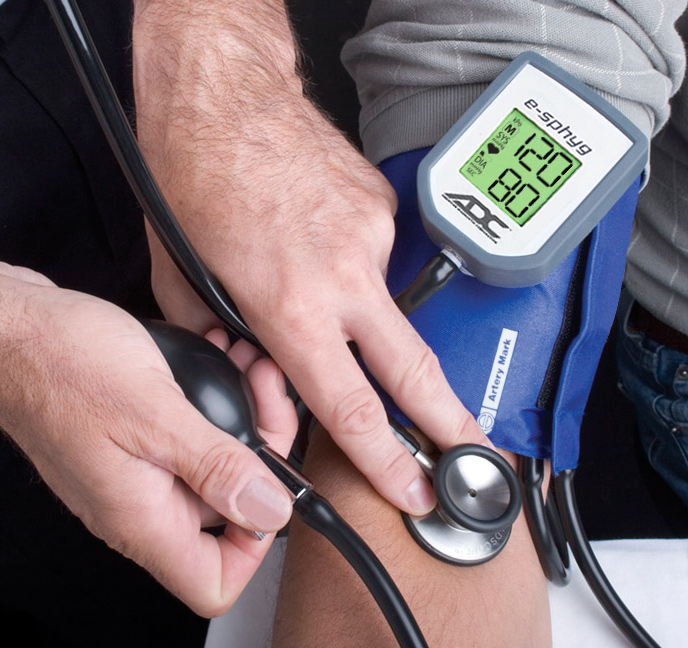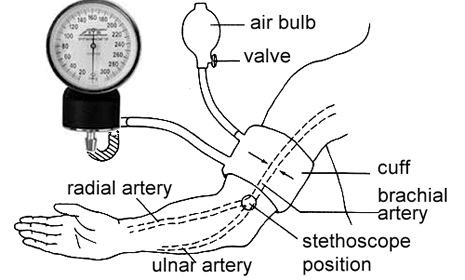Blood pressure AND deflat rate. The relaxed subject sits on a chair with the lower arm supported as before.
Performing mediate auscultation using a stethoscope is an important part of a physical examination and may allow for the identification of a variety of illnesses that might otherwise go undetected.
. This will measure your blood pressure together with the inflatable cuff. The ideal range is 90-120 mm Hg. Beyond the ankle another alternative is a calf-based blood pressure reading.
For the following blanks you must include artery in your answer ie. The lower end of the blood pressure cuff is placed 2-3 cm above the antecubital fossa which should be at approximately the same vertical height as the heart while allowing room for the stethoscope. Easy to use with an adjustable Velcro strip for easy placement and removal and a specially designed fastening tool.
Performing mediate auscultation using a stethoscope is an important part of a physical examination and may allow for the identification of a variety of illnesses that might. To take your blood pressure you inflate the cuff around your upper arm. The brachial pulse is palpated just above the angle of the elbow the antecubital fossa.
Blood pressure AND stethoscope AND placement OR location 4. Position the chestpiece in the antecubital space below the cuff distal to the brachium. Do not apply pressure too firmly because this can distort the Korotkoff sounds.
We offer sphygmomanometers constructed with precision and quality materials to. Interval between repeated measurements. PLACE THE BELL OR THE DIAPHRAGM HEAD of the stethoscope lightly over brachial artery at the bend of the elbow but with good skin contact.
Once you have estimated the systolic pressure through palpation place the head of the stethoscope lightly over the brachial artery in the antecubital fossa. There are certain guidelines to be followed in order to obtain accurate blood pressure readings. Blood pressure AND diaphragm AND bell.
1 If the cuff has no center arrows estimate the center of the bladder and place it. Systolic Blood Pressure SBP is the high arterial pressure caused by contraction of the left ventricle. NOVAMEDIC Professional Pediatric Size Blood Pressure Machine and Stethoscope Set Blue Arm Cuff 72-105 Professional Aneroid Stethoscope BP Monitor for Emergency Medical Supplies Carrying Case.
During the blood pressure measurement the doctor will place the stethoscope on the brachial artery which is in your arm to listen to your blood flow. 2 The appearance and. Blood pressure measur AND talk OR talks OR talking 28.
Apply the cuff by centering the arrows marked on the cuff over the popliteal artery so that the lower edge of the cuff is 2 to 3 cm about 1 inch above the popliteal fossa. 1 A trained clinician or nurse uses the stethoscope to listen for the Korotkoff sounds associated with blood flowing through the brachial arm artery as a BP cuff encircling the upper arm is deflated. It is essential that a patient does not consume alcohol tobacco and caffeine 30 minutes prior to.
If your answer is. When measuring blood pressure BP using the auscultation method a stethoscope is commonly used. Do not place chestpiece underneath the cuff as this impedes accurate measurement.
Download for free at Open Stax. Position the chestpiece in the antecubital space below the cuff distal to the brachium. Blood Pressure Cuff Placement For the best cuff placement it should be wrapped around the upper arm just above your elbow bend.
The standard for blood pressure cuff placement is the upper arm using a cuff on bare skin with a stethoscope placed at the elbow fold over the brachial artery. In clinical practice it is sometimes placed under the cuff but more usually outside the cuff on the antecubital fossa. Your patient has a blood pressure of 142100.
Manual models are like the ones that might be used in your doctors office. The blood pressure cuff is placed on the subjects right arm allowing 1 inch between the bottom of the cuff and the crease of the elbow. Placement of blood pressure cuff Bottom of the cuff should be placed directly above the antecubital fossa bend of the elbow.
Blood pressure is usually checked using a stethoscope in combination with a mercury sphygmomanometer. Blood pressure AND stethoscope AND placement OR location 4. Placement of the stethoscope on the left facing the patient inter-costal space between rib 2 and 3 will allow for the sound produced by the -----valve to be heard.
Position the bell of the stethoscope over where you felt the pulsation of your brachial artery. Stethoscope Placement for Auscultation. They usually include an arm cuff a squeeze bulb to inflate the cuff a stethoscope or microphone and a gauge to measure the blood pressure.
The manual auscultatory method is the gold standard for clinical BP measurement and requires a cuff a stethoscope and a cuff pressure display. This is known as----- 2. Stethoscope Placement for Auscultation by Open Stax CC BY 40.
Stethoscope placement patient positioning and familiarity with heart. Lawrence A low index number warns the Mayo Clinic likely indicates arterial narrowing or blockage in the legs. Listen to the blood flow.
Partially tuck the bell of the stethoscope under the blood pressure. Place the inflatable blood pressure cuff securely on the upper arm. Two it frequently results in less room and may cause the cuff placement to be too low.
Avoid too much pressure which can close off. Take multiple readings Take at least 2 readings 1 minute apart in the morning before taking medications and in the evening before supper. You can compare systolic ankle leg pressure to systolic brachial arm blood pressure and this is termed the ankle-brachial pressure index ABPI says Dr.
The cuff should be placed snugly around the upper arm and the bladder of the cuff should cover at least 80 of the arms circumference. Which are the main blood. Stethoscope placement for auscultation of the lungs.
The correct positioning of the cuff as shown by the Artery Mark and stethoscope for optimal measurement. Uncross their legs each time you are ready to take a blood pressure reading 12. Optimally measure and record BP daily.
INSERT the stethoscope earpieces angled forward to fit snugly. The normal blood pressure reading for a healthy individual is 12090. A built-in stethoscope bell be sure to position the cuff so the bell is over the artery.
Stethoscope placement for auscultation of the heart. However there is little scientific evidence to quantify the BP difference between the BP measurements taken with.

Blood Pressure 2 Procedures For Measuring Blood Pressure Nursing Times

Bio 450 Lab 8 Human Cardiopulmonary Function
Vital Signs Client Care Nursing Part 5
Chapter 4 Cardiovascular Experiments Anatomy And Physiology 2 Lab Manual

How To Take Blood Pressure American Diagnostic Corporation
Stethoscope Bell And Sphygmomanometer Cuff Placement

Ppt This Demonstrates The Location Of The Cuff And Placement Of The Stethoscope For Taking Blood Pressure Powerpoint Presentation Id 632605


0 comments
Post a Comment